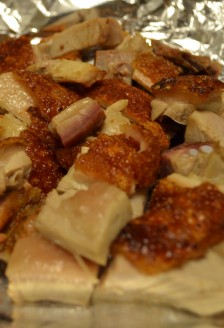Happy Chinese New Year!
Chinese New Year, mini Mandarin oranges, loose leaf tea and lucky red envelopes
Believe it or not, the best thing about Chinese New Year is not the little lucky money envelopes filled with money, it’s the food! Each Chinese dish served at Chinese New Year carries symbolic meaning making New Year’s dinner a significant and tasty tradition in most Chinese families.
Traditional Chinese meals are served ‘family-style,’ where plates of food are placed in the middle of the table and everyone shares, making the meal both a lively and intimate affair. And if you’ve ever dined with a Chinese family, you’ll know what I mean. The dinner table is filled with chatter, laughter and activity, as everyone shares stories and reaches to the middle of the table with their chopsticks to help themselves to the communal plates of food.
There are a few mandatory items served during Chinese New Year dinner that hold special meaning to the annual holiday. Let’s just put it this way, you cannot properly enjoy Chinese cuisine if you’re a vegetarian. Especially during Chinese New Year.
Chinese New Year dinner: steamed white fish
A whole steamed white fish, the belly stuffed with ginger is a traditional dish symbolizing good luck and abundance of wealth. It’s important that the fish is steamed in whole, tail included, eyeballs intact too. In fact many items on the Chinese New Year dinner menu are required to be cooked in whole to signify unity, whole chickens are usually also steamed and served with a green chive and oil sauce, whole ducks are barbecued, and my absolute favourite meat during this time of year is the suckling pig with its crispy, crackling skin and its tender and moist, fatty meat. Somehow pigs in Chinese culture have always been associated with good luck; this may be due to the fact that their plump bodies may also represent abundance and happiness.
Chinese New Year dinner: suckling pig
Chinese New Year dinner: prawns with noodles
Happiness on the dinner table is also represented by prawns. In Cantonese, the word prawn sounds like the laughing sound, ‘ha ha.’ Therefore prawns are always served at Chinese New Year, signifying a year filled with joy and laughter. Also mandatory on the dinner table are ‘long-life’ noodles, representing a long prosperous life of good luck and good health. My favourite noodles are called ‘yee mein,’ and are often served with lobster, and have almost the same texture as ramen noodles. I love that the noodles are slightly flat and curly, trapping flavour in every wrinkle of their long strands.
Chinese New Year dinner: lobster yee mein (noodles)
Other food and gift items exchanged between families and friends during the Chinese New Year (in addition to lucky money) include loose leaf teas, also served during and after meals, mini Mandarin oranges called ‘gum gut,’ literally meaning golden oranges, and my personal favourite, Chinese New Year cake, aka Nian Gao.
Chinese New Year: loose leaf teas
Chinese New Year: mini Mandarin oranges
Nian Gao is a cake made from glutinous rice flour and is sticky and rich. The round shape represents family togetherness, and the sweet and sticky texture of the cake signifies a year of rich happiness. The cake can just be eaten plain, cut into squares and eaten with your fingers. But traditionally, the little squares of cut-up cake can also be dipped in an egg batter and lightly fried, making the cake even stickier and tastier as it melts in the frying pan.
Chinese New Year cake 'Nian Gao'
I can’t end this post without talking about the little red envelopes, of course. They now come in all shapes and sizes. I must say that I like the longer envelopes as opposed to the compact squares ones. I don’t like my dollar bills to be folded in half to fit in a lucky red envelope. There’s nothing better than peeling open a lucky red envelope to find a perfectly crisp $100 bill. Of course if there was a square of Chinese New Year cake inside too, it would sweeten the deal even more.
Chinese New Year lucky red envelopes
Chinese New Year lucky red envelopes




4 Responses to Happy Chinese New Year!
Melody Fury
on January 30, 2011
Nian Gao dipped in egg + pan fried is my favourite! Happy new year, ange xoxo
food punk
on January 30, 2011
Yup, it’s the best! I spend all year craving it… Happy New Year to you too, Melody!
Anabel
on February 3, 2011
Oh geesh….all that food, you’re right food is the BEST thing about holidays…and lobster yee mein is my ABSOLUTE favourite chinese dish…YUM.
P.S. Got your post about the G ramen place. I’ve added it to my list for my next trip to Vancity, thank you!
food punk
on February 5, 2011
Thanks for reading Happy New Year! May you eat to your heart’s content!
Happy New Year! May you eat to your heart’s content!